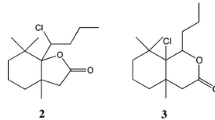Abstract
The larvae of a rare noctuid moth, Lasionycta wyatti, were found to be associated with the stems and roots of Ambrosia chamissonis, a species found along sandy beaches in western North America. High-performance liquid chromatographic (HPLC) analyses of L. wyatti larvae and their frass revealed significant amounts of thiarubrines, secondary compounds characteristic of this host plant. Artificial diet studies showed that thiarubrines were well tolerated by these larvae. These same diets, however, were toxic to larvae of Manduca sexta and inhibited larval growth of Spodoptera litura. Even in the presence of simulated sunlight, artificial diets containing thiarubrines did not affect larvae of L. wyatti. However, dietary incorporation of thiophenes, natural UV-activated breakdown products of thiarubrines, was deleterious to larvae of L. wyatti.
Similar content being viewed by others
REFERENCES
Aucoin, R., Guillet, G., Murray, C., PhilogÈne, B. J. R., and Arnason, J. T. 1995. How do insect herbivores cope with the extreme oxidative stress of phototoxic host plants? Arch. Insect Biochem. Physiol. 29:211-226.
Berenbaum, M. R., and Larson, R. A. 1988. Flux of singlet oxygen from leaves of phototoxic plants. Experientia 44:1030-1032.
Block, E., Page, J. E., Toscano, J., Wang, C.-X., Zhang, X., DeOrazio, R., Guo, C., Platz, M. S., Sheridan, R. S., and Towers, G. H. N. 1996. The photochemistry of thiarubrine A and other 1,2-dithiins: Formation of 2,6-dithiabicyclo[3.1.0]hex-3-enes. J. Am. Chem. Soc. 118:4719-4720.
Bomford, M. K., and Isman, M. B. 1996. Desensitization of fifth instar Spodoptera litura to azadirachtin and neem. Entomol. Exp. Appl. 81:301-313.
Champagne, D. E., Arnason, J. T., PhilogÈne, B. J. R., Morand, P., and Lam, J. 1986. Light mediated allelochemical effects of naturally occurring polyacetylenes and thiophenes from Asteraceae on herbivorous insects. J. Chem. Ecol. 12:835-858.
Constabel, C. P. 1988. Studies on thiarubrines, naturally occurring disufide polyines. MSc thesis. University of British Columbia, Vancouver, Canada, 62 pp.
Constabel, C. P., and Towers, G. H. T. 1989. The complex nature of the mechanism of toxicity of antibiotic dithiacyclohexadiene polyines (thiarubrines) from the Asteraceae. Planta Med. 55:35-37.
Crumb, S. E. 1956. The larvae of the Phalaenidac. USDA Technical Bulletin 1135:139, 356 pp.
Downum, K. R., Rosenthal, G. A., and Towers, G. H. N. 1984. Phototoxicity of the allelochemical, α-terthienyl, to larvae of Manduca sexta (L.) (Sphingidae). Pestic. Biochem. Physiol. 22:104-109.
Ellis, S. M. 1993. Thiarubrine production in roots and root cultures of Ambrosia chamissonis. MSc thesis. University of British Columbia, Vancouver, Canada, 125 pp.
Ellis, S. M., Balza, F., Constabel, P., Hudson, J. B., and Towers, G. H. N. 1995. Thiarubrines: Novel dithiacyclohexadiene polyyne photosensitizers from higher plants, pp. 164-178, in J. R. Heitz and K. R. Downum (eds.). Light Activated Pest Control. Symposium Series 616. American Chemical Society. Washington, D.C.
Fields, P. G., Arnason, J. T., and PhilogÈne, B. J. R. 1990. Behavioral and physical adaptations of three insects that feed on the phototoxic plant. Hypericum perforatum. Can. J. Zool. 68:339-346.
Godfrey, G. L. 1972. A review and reclassification of larvae of the subfamily Hadeninae (Lepidoptera: Noctuidae) of America north of Mexico. USDA Technical Bulletin 1450, pp. 102-103.
Guillet, G., PhilogÈne, B. J. R., O'Meara, J., Durst, T., and Arnason, J. T. 1997. Multiple modes of insecticidal action of three classes of polyacetylene derivatives from Rudbeckia hirta. Phytochemistry 46:495-498.
Hudson, J. B., Graham, E. A., Fong, R., Finlayson, A. J., and Towers, G. H. N. 1986a. Antiviral properties of thiarubrine A, a naturally occurring polyine. Planta Med. 1:51-54.
Hudson, J. B., Graham, E. A., Chan, G., Finlayson, A. J., and Towers, G. H. N. 1986b. Comparison of the antiviral effects of naturally occurring thiophenes and polyacetylenes. Plant Med. 6:453-457.
Ivie, G. W., Bull, D. L., Beier, R. C., Pryor, N. W., and Oertli, E. H. 1983. Metabolic detoxification: mechanism of insect resistance to plant psoralens. Science 221:374-376.
Iyengar, S., Arnason, J. T., PhilogÈne, B. J. R., Morand, P., Werstiuk, N. H., and Timmins, G. 1987. Toxicokinetics of the phototoxic allelochemical α-terthienyl in three herbivorous Lepidoptera. Pestic. Biochem. Physiol. 29:1-9.
Lam, J., Bildsoe, H., Christensen, L. P., and Thomasen, T. 1989. Chemical constituents of Santolina chamaecyparissus. Acta Chem. Scand. 43:799-802.
Page, J. E., Huffman, M. A., Smith, V., and Towers, G. H. N. 1997. Chemical basis for Aspilia leaf-swallowing by chimpanzees: A reanalysis. J. Chem. Ecol. 23:2211-2226.
Towers, G. H. N., Abramowski, Z., Finlayson, A. J., and Zucconi, A. 1985. Antibiotic properties of thiarubrine A, a naturally occurring dithiacyclohexadiene polyine. Planta Med. 3:225-229.
Truong, T. V., Bierer, D. E., Dener, J. M., Hector, R., Tempesta, M. S., Loev, B., Yang, W., and Koreeda, M. 1997. Novel 1,2-dithiin antiinfective agents. US Patent 5,668,168.
Author information
Authors and Affiliations
Rights and permissions
About this article
Cite this article
Dojillo-Mooney, J., Page, J.E., Isman, M.B. et al. Tolerance to Thiarubrines from Ambrosia chamissonis by the Rare Moth Lasionycta wyatti . J Chem Ecol 25, 1369–1382 (1999). https://doi.org/10.1023/A:1020982927255
Issue Date:
DOI: https://doi.org/10.1023/A:1020982927255




